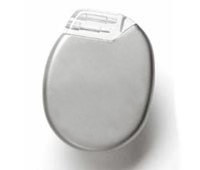Pacemaker and Defibrillator Implantation
What are pacemakers and defibrillators?

Pacemaker
Pacemaker
A pacemaker is a small device that helps the heart beat at a regular rhythm and rate. It can send electrical pulses if the heart is beating too slowly or skipping beats or if the heart’s chambers are not squeezing in sync. A doctor places the pacemaker inside the body (implantation).

Defibrillator
Defibrillator
A defibrillator (implantable cardioverter defibrillator, or ICD) is similar to a pacemaker. It sends electrical shocks to the heart if the heart beats in a disorganized way (chaotically). A defibrillator is also placed inside the body by a doctor.
When do we arrive for the appointment?
You will receive a phone call 48 hours before the procedure. This will include details about when your child needs to stop eating and drinking, when to arrive at the hospital and where to check in.
What happens before the procedure?
A nurse will ask general health questions, and your child will have a brief physical exam that includes weight and height measurements.
Your child’s electrophysiologist will meet you to see if there have been any recent changes in your child’s health and to answer any further questions you might have.
You will also meet the pediatric anesthesiologist who will be giving anesthesia during the procedure. The anesthesiologist may give some medicine to help your child relax through a tiny plastic tube in a vein (IV line).
We will give you a pager so your child’s team can page you with updates during the surgery. We will let you know when your child’s procedure is done.
What happens during the procedure?
The anesthesiologist will give your child medicines to get them to sleep and keep them from feeling any pain during the procedure.
The electrophysiologist then makes a small cut, about 2 inches long, just below your child's collarbone for the pacemaker or defibrillator.
The surgeon then threads 1 or 2 small, flexible wires (leads) through the veins of the chest into the heart, using X-ray imaging to guide them. The leads are attached to the pacemaker or defibrillator under the skin, and the cut is stitched closed.
When a defibrillator is put in, the surgeon tests the device to make sure that it will work when needed. To do this, the surgeon puts the patient’s heart into an abnormal rhythm (arrhythmia) while closely monitoring them. The device detects the arrhythmia and restores the heart to its normal rhythm.
Your child will receive antibiotics before and after the procedure. The electrophysiologist will recheck the device to make sure that it is working well and then cover everything with a sterile dressing.
During the procedure, you can wait anywhere in the hospital that is comfortable for you because you will have a pager to get updates. A nice place to wait is the Family Resource Center.
How long does the procedure take?
Inserting a pacemaker or defibrillator takes about 3 hours.
After several years (usually 7 to 8 years), the battery in the device will begin to get low and the doctor will need to replace the device. Often the leads are still fine and can stay in place. Sometimes new leads are needed. If the doctor only has to change the device, not the leads, the procedure may only take 1 to 2 hours.
What happens after the procedure?
After the procedure, your child will wake up in the recovery room, where they will stay for about an hour.
Nurses will check your child and help them wake up enough to eat and drink. The electrophysiologist will check an X-ray to make sure that the leads are still in place and properly attached to the pacemaker or defibrillator.
When can my child go home?
If your child is getting a new pacemaker or defibrillator, they will spend the night and go home the next day. Your child will get antibiotics overnight and pain medicine if they are uncomfortable. The next morning, the electrophysiologist will check another X-ray and the electrophysiology nurse will test the device to make sure it is working properly. This is a good time to ask questions about activity, school and anything else about your child’s new device.
Before your child goes home, a nurse will review with you:
- Signs to watch for after the procedure
- Safe ways to hold and lift your child
- Medicines to give
- How to help your child slowly increase their activity
Read more about care of your child with a pacemaker (PDF) (Spanish).
Contact Us
Contact the Heart Center at 206-987-2515 for a referral, a second opinion or more information.
Providers, see how to refer a patient.
Paying for Care
Learn about paying for care at Seattle Children’s, including insurance coverage, billing and financial assistance.